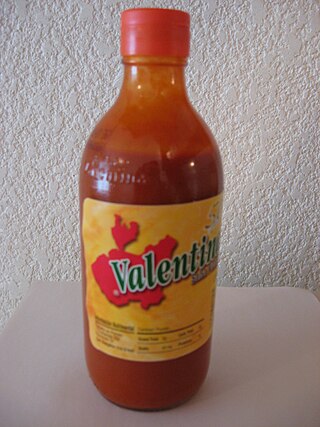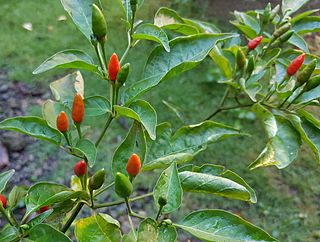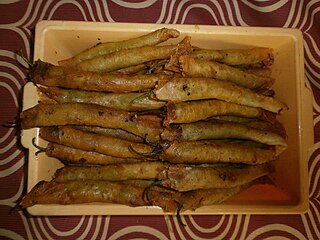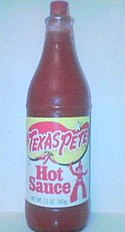
The Scoville scale is a measurement of pungency of chili peppers and other substances, recorded in Scoville heat units (SHU). It is based on the concentration of capsaicinoids, among which capsaicin is the predominant component.

Chili peppers, from Nahuatl chīlli, are varieties of the berry-fruit of plants from the genus Capsicum, which are members of the nightshade family Solanaceae, cultivated for their pungency. Chili peppers are widely used in many cuisines as a spice to add "heat" to dishes. Capsaicin and related compounds known as capsaicinoids are the substances giving chili peppers their intensity when ingested or applied topically. Chili peppers exhibit a wide range of heat and flavor profiles. This diversity is the reason behind the availability of different types of paprika and chili powder, each offering its distinctive taste and heat level.

Scotch bonnet is a variety of chili pepper named for its supposed resemblance to a Scottish tam o' shanter bonnet. It is ubiquitous in West Africa as well as the Caribbean. Like the closely related habanero, Scotch bonnets have a heat rating of 100,000–350,000 Scoville units. For comparison, most jalapeño peppers have a heat rating of 2,500 to 8,000 on the Scoville scale. However, completely sweet varieties of Scotch bonnet called cachucha peppers are grown on some of the Caribbean islands.

Sodium benzoate also known as benzoate of soda is the sodium salt of benzoic acid, widely used as a food preservative (with an E number of E211) and a pickling agent. It appears as a white crystalline chemical with the formula C6H5COONa.

Hot sauce is a type of condiment, seasoning, or salsa made from chili peppers and other ingredients. Many commercial varieties of mass-produced hot sauce exist.

Cholula Hot Sauce is a brand of chili-based hot sauce, based in Stamford, Connecticut, manufactured in Chapala, Jalisco, Mexico, and licensed by José Cuervo. According to its manufacturers, Cholula hot sauce rates 1,000–2,000 on the Scoville scale though other sources measure it as being over three times as hot, at 3,600 Scoville units. The product is packaged in a glass bottle with a distinctive round wooden cap. Six varieties of Cholula are widely marketed in North America.
Benzene in soft drinks is of potential concern due to the carcinogenic nature of the molecule. This contamination is a public health concern and has caused significant outcry among environmental and health advocates. Benzene levels are regulated in drinking water nationally and internationally, and in bottled water in the United States, but only informally in soft drinks. The benzene forms from decarboxylation of the preservative benzoic acid in the presence of ascorbic acid and metal ions that act as catalysts, especially under heat and light. Hot peppers naturally contain vitamin C so the observation about soft drinks applies to pepper sauces containing sodium benzoate, like Texas Pete.

Valentina is a brand of "pourable" hot sauce manufactured by Salsa Tamazula, a company based in Guadalajara, Mexico. The sauce, like the parent company's Tamazula hot sauce, is made with puya chilis from Jalisco state, similar to the Guajillo chili and known by the name guajillo puya.

Tapatío is an American hot sauce produced in Vernon, California. It is popular mainly in the United States, predominantly among Mexican American communities.
Búfalo is a brand of hot sauce and other condiments produced by Herdez Group of Lomas de Chapultepec, Mexico. Búfalo sauce has been produced since 1933. The company produces Búfalo and Tampico sauces, salsas, and other condiments. In the United States, English-labeled bottles are distributed by MegaMex Foods, a joint venture between Herdez and Hormel Foods.

The Naga Morich is a chili pepper grown in Northeast India and Bangladesh. There is no consensus on whether this is synonymous with the Bhut Jolokia, or a different variety. It is also one of the hottest known chilli peppers and the only naturally occurring chili pepper that measures 1 million SHU on Scoville scale. Morich is the word for chilli pepper in Bengali, with similar words in Assamese:, Nepali, Hindi and the languages of Nagaland and Manipur.

Siling labuyo is a small chili pepper cultivar that developed in the Philippines after the Columbian Exchange. It belongs to the species Capsicum frutescens and is characterized by triangular fruits which grow pointing upwards. The fruits and leaves are used in traditional Philippine cuisine. The fruit is pungent, ranking at 80,000 to 100,000 heat units in the Scoville Scale.

Blair's Sauces and Snacks is a United States snack company founded in 1989, most famous for their Death Sauce line of hot sauces, known for their extreme range in Scoville heat ratings.

A guajillo chili or guajillo chile or chile guaco or mirasol chile is a landrace variety of the species Capsicum annuum with a mirasol chile fruit type. Mirasol is used to refer to the fresh pepper, and the term guajillo is used for the dry form, which is the second-most common dried chili in Mexican cuisine. The Mexican state of Zacatecas is one of the main producers of guajillo chilies. There are two main varieties that are distinguished by their size and heat factors. The guajillo puya is the smaller and hotter of the two. In contrast, the longer and wider guajillo has a more pronounced, richer flavor and is somewhat less spicy. With a rating of 2,500 to 5,000 on the Scoville scale, its heat is considered mild to medium.

Crushed red pepper or red pepper flakes is a condiment or spice consisting of dried and crushed red chili peppers. This condiment is most often produced from cayenne-type peppers, although commercial producers may use a variety of different cultivars, usually within the 30,000–50,000 Scoville unit range. Often there is a high ratio of seeds, which are erroneously believed to contain the most heat. Crushed red pepper is used by food manufacturers in pickling blends, chowders, spaghetti sauce, pizza sauce, soups and sausage.
D’Elidas is the brand name for a hot sauce produced by Productos D’Elidas S.A in Panama. The D’Elidas original yellow hot sauce is made from the main ingredients "Aji Chombo", mustard and vinegar.

Huy Fong's sriracha sauce, also referred to as sriracha, cock sauce or rooster sauce due to the rooster on its label, is a brand of sriracha, a chili sauce that originated in Thailand. The sauce is produced by Huy Fong Foods, a California manufacturer, and was created in 1980 by David Tran, a Chinese immigrant to the US from Vietnam.

The habanero is a hot variety of chili. Unripe habaneros are green, and they color as they mature. The most common color variants are orange and red, but the fruit may also be white, brown, yellow, green, or purple. Typically, a ripe habanero is 2–6 centimetres long. Habanero chilis are very hot, rated 100,000–350,000 on the Scoville scale. The habanero's heat, flavor, and floral aroma make it a popular ingredient in hot sauces and other spicy foods.

Dinamita is a deep-fried Filipino snack consisting of stuffed siling haba wrapped in a thin egg crêpe. The stuffing is usually giniling, cheese, or a combination of both but it can also be adapted to use a wide variety of ingredients, including tocino, ham, bacon, tuna, and shredded chicken. Dinamita is also known as dynamite lumpia, among other names. It is a type of lumpia and it is commonly eaten as an appetizer or as a companion to beer.
















